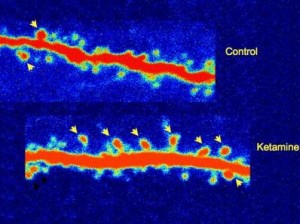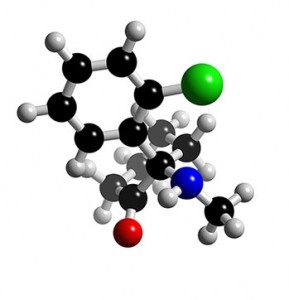One in five people will be affected by mood disorders – such as major depression – in their lifetime. Many others suffer from Post Traumatic Stress Disorder, Bipolar disorder and severe Anxiety. These are debilitating illnesses that cause terrible pain and impact their family, friends, and co-workers. Fortunately, there is hope. Current research is showing IV Ketamine Infusion Therapy as one of the most effective ways to treat mood disorders, particularly depression and PTSD.
Those studies and our six years of clinical experience show Ketamine Infusion Therapy is an excellent treatment for rapid relief of overwhelming symptoms, often times improvements are seen within hours of the first infusion. No other treatment has resulted in such dramatic and immediate results, particularly with such an excellent safety profile. When Ketamine Infusion Therapy is coupled with additional supportive services we offer in our office, we see an even higher success rate.
If you have any questions about the treatment or want to schedule a consult, give our office a call at 209.549.1600.
New Patient Questionaire Therapy Cost/ABN Ketamine Infusion InstructionsQuestions & Answers
Your Ketamine Infusion Therapy
Our primary focus is providing immediate and long term relief to our patients with this breakthrough treatment. Initially, you will consult with Dr. Tremayne to begin treatment. Most patients require routine labs and an ECG, prior to Ketamine Infusion Therapy. We know how urgent the need for treatment is for many of our patients and we waste no time in beginning the treatment process. If you are a current patient, we can often arrange treatment within 1-2 days. Ketamine has the unique quality of being one of the safest anesthetic drugs available, often used in pediatrics and in patients with severe medical trauma. The dosage used for our purpose, is very low by comparison.
What is Ketamine?
Ketamine has been around for about 50 years and is regarded as safe for use as a surgical anesthetic and is approved by the FDA for that purpose. It has been used as an anesthetic on the battlefield since the Vietnam war. It is perhaps the most commonly used sedation agent in the world and is often used for children undergoing dental or medical procedures. Its use for treating depression/PTSD is an “off label” use that has not been approved by the FDA. Off-label use of medication is common for many conditions today and comprises 20% of all drugs sold in the United States.
Typical depression/PTSD treatment?
Depression/PTSD is associated with decreased neuron synapses or activity in various regions of the human brain. Typical antidepressant medications attempt to block or reverse these neuron deficiencies, and often take weeks to months to work and then only with limited success. With these medications there are frequent side effects, such as, weight gain, fatigue, memory loss and decreased libido.
How does Ketamine work?
Ketamine produces rapid antidepressant responses in patients with major depression and PTSD disorder. The studies show that Ketamine triggers the release of the neuro-transmitter glutamate, which in turn stimulates the growth of synapses. In fact, Ketamine has been shown to stimulate the growth of synapses within 1 hour of treatment. It has an immediate effect on the brain; is thought to reset the brain in the moment, and potentially long term with on-going treatments.
How soon will my symptoms improve?
Typically, patients who respond to the treatment begin feeling better in the hours following the infusion therapy. Patients have reported waking up the following day, with a much better outlook and disposition. Patients report sleeping better, increased tolerance of life stressors, feeling closer to their family and having an overall sense of calmness and peace. Many patients report much greater outcome from counseling after having Ketamine Infusion treatment.
What will I experience during the infusion?
After getting comfortable, our nurse will start an IV line containing saline solution. The physician will then determine the appropriate dose of Ketamine to relieve of your particular symptoms. The Ketamine is administered over a 45-minute period. Patients may feel slightly tired, or drift off to sleep, others are awake, and talking with minimal sedative effect. Recovery takes about 15 minutes and then may leave with an adult driver.
How long can I expect treatment to last?
Those in the medical community studying Ketamine therapy have found the best protocol for treatment is to have five to six consecutive infusions or within a 2-4 week time period, depending on severity of conditions. After that, it may necessary to repeat the treatment to maintain remission, it is determined on an individual basis. We suggest an additional treatment in about 3-4 weeks following the initial therapy sessions. Our experience suggests that the treatments are required less frequently recovery continues. Typically, patients are seen every 4-8 weeks for the next few months after stabilization. This time frame differs for each patient; some require less, others may require more.
What are the common side effects?
The side effects of Ketamine therapy typically occur during the infusion but subside when the therapy concludes. The most common side effects, that some patients have, not all, are nausea, drowsiness, during the Ketamine infusion. Patients often find it best to rest for the duration of the infusion. As Ketamine may cause a slight increase in blood pressure and heart rate, the nursing staff will closely monitor your vitals and provide treatment if needed during the infusion. We have not seen this in our practice, as this is a rare side effect, however we still monitor closely.
What are the risks?
In clinical settings, the low doses of Ketamine used in the infusion therapy are well-tolerated by patients. In our experience, we are aware of no significant adverse reactions to Ketamine used a these low doses. Interstitial cystitis has been documented with abuse or long term use of high doses of Ketamine, but not in this setting when using low doses. Again, this is a very rare side effect.
What is the potential to become addicted?
Ketamine is not physically addictive; in fact, Ketamine is well known to be used in the treatment of addiction. The low dose of Ketamine you will receive and the medically supervised setting in which it will be administered offers a little to no potential for addiction.
Are there any medical conditions that will preclude treatment?
A consultation with the physician is required prior to participating in the Ketamine infusion therapy program. At that consultation, any medical conditions that would preclude treatment will be discussed.
What is Dr Tremayne’s experience with Ketamine Infusion Therapy?
Dr. Tremayne has six years of clinical experience providing IV Ketamine to patients in the Modesto area. She also collaborates with several leading physicians across the country in the forefront of treatment and IV Ketamine infusion. She consults with Dr Nam Tran, local anesthesiologists’ for complex cases. All patients participating in the Ketamine Infusion Therapy program are closely monitored by an experienced RN.
Dr. Tremayne’s passion for making a true difference in patients’ lives and training and practice in counseling, coupled with her mastery of internal medicine and critical care medicine, makes her uniquely qualified to provide Ketamine Infusion Therapy.
What is Dr. Tremayne’s background?
Dr. Tremayne is board certified in Internal Medicine. She holds a Masters Degree in Psychology, and practiced as a crisis counselor prior to attending medical school. After medical school, she spent ten years practicing hospital /critical care medicine in San Joaquin Valley, before opening Tremayne Center for Medicine nine years ago, to better serve the community she was born and raised in.
Research/ Articles
“The Ketamine Cure, Is Ketamine the best hope for curing major depression?”by Caroline Winter, August 19,2015
“‘I Wanted To Live: New Depression Drugs Offer Hope For Toughest Cases,” January 31, 2012, by Jon Hamilton, National Public Radio Morning Edition
“Ketamine for Depression: The Most Important Advance in Field in 50 Years?” –by Maia Szalavitz, October 5, 2012, TIME
“A Dry Pipeline for Psychiatric Drugs” –by Richard A. Friedman, MD, August 19, 2013, The New York Times
“Yale scientists explain how ketamine vanquishes depression within hours,” October 4, 2012
“Ketamine Encourages Nerve Remodeling “-by Jef Akst, October 16, 2012, The Scientist
“Ketamine ‘Exciting’ Depression Therapy” -by James Gallagher, April 2, 2014, The BBC
“Ketamine May Help Treat Severe Depression, Reduce Suicidal Urges, UAB Researchers Say” -March 27, 2013 Medical News
Ketamine – Mechanism of Action
Ketamine operates by blocking the N-methyl-D-aspartate (NMDA) glutamate receptor Ca2+ channel to reduce the presynaptic release of glutamate; however, the exact mode of action is not known. Some researchers speculate that increasing free glutamate in turn stimulates postsynaptic α-amino-3-hydroxy-5-methyl-4- isoxazolepropionic acid (AMPA) receptors, which then mediate fast, excitatory neurotransmission. Ketamine’s antidepressant actions might instead be the result of AMPA stimulation rather than only an NMDA receptor blockade.
The rapid antidepressant effects of ketamine are associated with fast induction of synaptogenesis and the reversal of atrophy caused by chronic stress.(9) In other words, ketamine seems to actually rebuild synapses.
The effectiveness of ketamine in treating pain has been tied to its effects on the NMDA receptor, the AMPA receptors, as well as on the m-opioid receptors; however, some researchers have also pointed to the restoration of balance in the glutamate/ γ-Aminobutyric acid (GABA) system.
Pharmacology
Ketamine (ketamine hydrocholoride), a Schedule III class drug, is a dissociative anesthetic and analgesic used in both children and adults.
Ketamine is highly soluble in lipids and easily crosses the blood-brain barrier. Following intravenous administration, ketamine concentration has an initial phase, corresponding to its anesthetic effect, lasting about 45 minutes (with a serum half-life of 10 to 15 minutes). The anesthetic action ends through redistribution from the central nervous system to peripheral tissues and metabolic transformation to norketamine, which has about one-third the activity of ketamine. The elimination half-life of ketamine is about 2.5 hours.(1)

Figure 1. Neuronal spines, budding connections between brain cells, or synapses, sprouted in rats within hours of receiving ketamine (arrows). By contrast, fewer spines developed on neurons of control rats that didn’t receive the drug. The boost in neuronal connectivity is thought to produce an antidepressant effect by enhancing brain circuit activity. The highly magnified two photon imaging pictures show extensions of neurons in rat prefrontal cortex.
Federal Drug Administration Ketamine Overview

Figure 1. The Chemical structure of Ketamine.
(Excerpt from the Federal Drug Administration Website)
Ketamine is an anesthetic that has been used on both humans and animals for over 52 years. Its ability to anesthetize patients quickly and safely, with few side effects, was quickly realized by the medical community; it was approved by the Food and Drug Administration (FDA) in 1970. It rapidly became a necessity to doctors all over the world because it doesn’t depress patients’ breathing or circulatory systems like other anesthetics. It is also commonly used as a pain killer for this reason, especially for severe injuries and in crisis situations, since slowing respiration and circulation is a major problem with alternatives, such as opiates and barbiturate analgesics. It’s also very fast-acting.
Ketamine is one of only two anesthetics listed by the World Health Organization (WHO) as an “essential drug”. The WHO is a specialized agency of the United Nations concerned with international public health. Their essential drugs are “those drugs that satisfy the health care needs of the majority of the population; they should therefore be available at all times in adequate amounts and in appropriate dosage forms, at a price the community can afford”. WHO’s essential drugs are the basis for many countries’ national drugs policy.
These three factors make IV Ketamine Infusion Therapy the ideal treatment for chronic pain. Ketamine can block and “reset” pain receptors in the brain and balance out important neurons and hormones by changing glutamate and GABA levels, simultaneously addressing the physical and psychological discomfort caused by chronic pain and CRPS/RSD.


